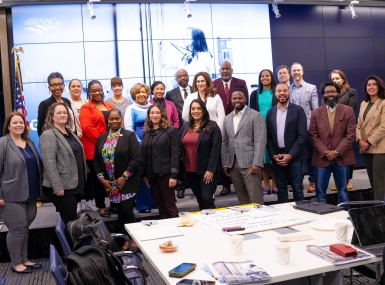The OMB Uniform Guidance: What It Is and Why It Matters to Counties and Nonprofits
Author
David L. Thompson
Upcoming Events
Related News
POINT OF VIEW
Historic grants reforms published by the federal government in late 2014 are now the law of the land. The reforms apply to federal grant funds that flow to states, counties, cities and nonprofits throughout the U.S.
If the federal reforms are implemented as intended, they promise to enhance programs and improve the lives of constituents and communities that counties and nonprofits jointly serve.
The downside of ignoring the new rules — missed cost savings, lost opportunities, and embarrassing adverse audit findings and challenges — makes attention to these details a priority for counties and nonprofits alike. With those shared realities in mind, this article provides information about the new reforms that must now be followed to receive federal grants that pay for a great deal of the day-to-day work we all do.
The Uniform Administrative Requirements, Cost Principles, and Audit Requirements for Federal Awards, commonly known as the OMB Uniform Guidance became effective on Dec. 26, 2014 and apply to new or newly-revised contracts or grants using federal grant funds. The primary goal of the reforms is to provide consistency in the processes and procedures used in managing federal funds by all federal and non-federal entities.
But what systems changes are needed at the local level? And will these changes ultimately bring about desired improvements or avoidable disruptions to operations and programs? The answers to these and many other questions are the same for county governments and nonprofits: It all depends on how the new rules are implemented.
Of interest to counties and nonprofits providing services on their behalf, the OMB Uniform Guidance:
- Consolidates and streamlines OMB Circulars: The guidance seeks to reduce confusion, inconsistency and compliance costs by melding multiple OMB Circulars — including A-87 and A-102 for state and local governments and A-122 and A-110 for nonprofits, and A-133 for both — into one set of federal regulations. Common administrative procedures, common definitions, common timelines and common cost allocation rules should allow everyone to “speak the same language” when applying the rules to their work on the ground.
- Clarifies direct costs: The new regulations clarify numerous cost allocation rules and specify more costs that are reimbursable as direct costs. For instance, in certain circumstances, program administration (e.g., secretarial staff dedicated to a specific program) can be reported as direct, rather than as indirect costs, and therefore are recoverable.
- Requires payment of indirect costs: The grants reforms require pass-through entities (such as counties) to reimburse sub-recipients for their reasonable indirect costs when federal dollars are in the funding mix. This requirement means that counties must be paid for their indirect costs and, in turn, they must pay nonprofits for their indirect costs on grants and contracts.
The requirement reportedly was included in response to numerous government and independent studies demonstrating that failure to reimburse non-federal entities for legitimate and necessary indirect costs undermines both the sustainability of the entity doing the work and the effectiveness of the federal programs.
- Raises the single audit threshold from $500,000 to $750,000, thereby reducing the costs and administrative burdens for up to 5,000 smaller organizations.
- Reduces the complexity in reporting: The rules simplify and streamline reporting requirements regardless of the federal funding stream.
The challenge for counties and nonprofits alike is that the federal government is offering very little training on how the rules should be converted into systems changes. Yet, thousands of government officials and employees working at the local, state and federal levels are being called on to make thousands of decisions and then explain those decisions to thousands of nonprofit program, grants and contracting personnel.
Without prompt, consistent and transparent training, the likelihood is great that there will be inconsistency, misinterpretations and confusion that will adversely affect program and procurement efficiency.
The adverse consequences of failure to adequately implement the grants reforms can be severe, potentially resulting in disruptions of service that hurt the public, add costs, create negative audit findings and delay the realization of intended benefits of the federal grants reforms.
The OMB Uniform Guidance — given the right set of circumstances — can deliver on the promise that individuals receive the quality services they need when they need them; taxpayers get full value for the programs they are funding, and our communities are made stronger through efficient and effective partnerships between governments and nonprofits. The National Council of Nonprofits’ network of state associations of nonprofits stands ready to work with counties and states to promote these important goals through full implementation of the federal grants reform.
David L. Thompson is vice president of public policy for the National Council of Nonprofits, the nation’s largest network of charitable nonprofits.
Attachments
Related News

DOJ issues final rule for state and local governments to implement web-based accessibility standards
On April 8, the U.S. Department of Justice (DOJ) announced the release of a web accessibility final rule for state and local governments.

County Countdown – April, 22, 2024
Every other week, NACo’s County Countdown reviews top federal policy advocacy items with an eye towards counties and the intergovernmental partnership.

Equity task force shares preliminary ideas for report
NACo's Equity + Governance Task Force is working to identify, prioritize and develop tools and resources counties need to advance equity in our communities.